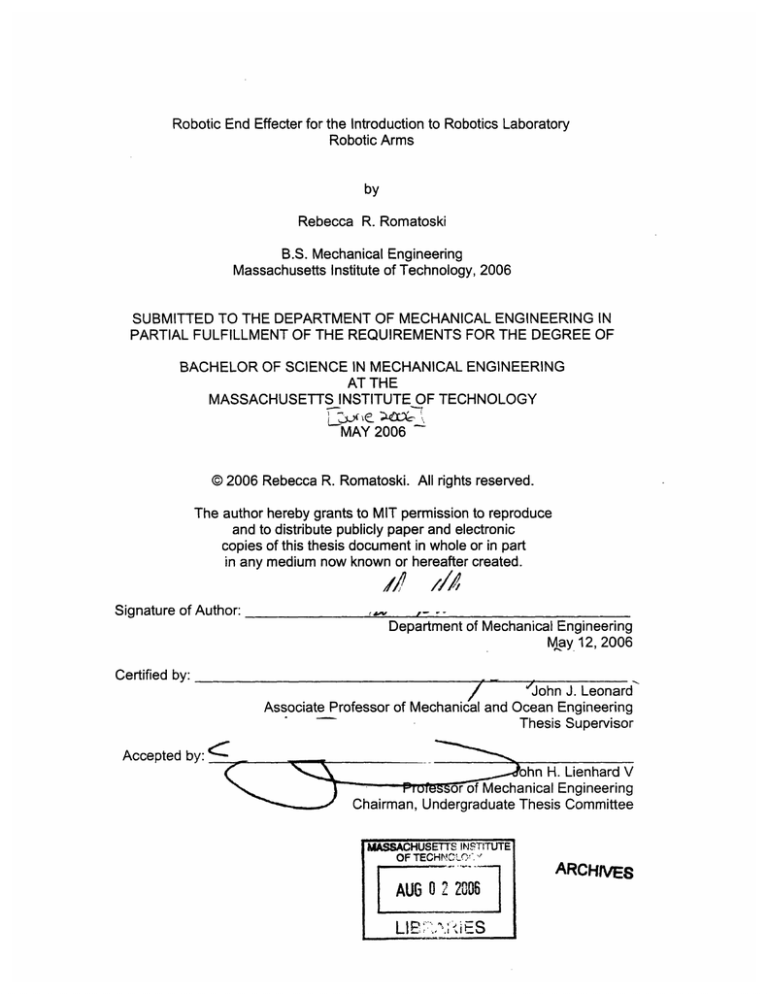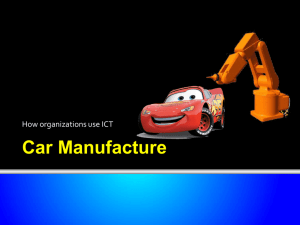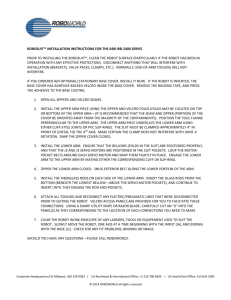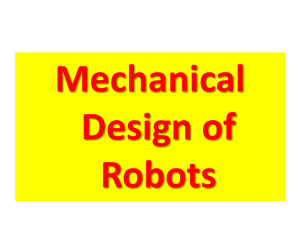Robotic End Effecter for the Introduction to Robotics ... Robotic Arms by Rebecca R. Romatoski
advertisement

Robotic End Effecter for the Introduction to Robotics Laboratory Robotic Arms by Rebecca R. Romatoski B.S. Mechanical Engineering Massachusetts Institute of Technology, 2006 SUBMITTED TO THE DEPARTMENT OF MECHANICAL ENGINEERING IN PARTIAL FULFILLMENT OF THE REQUIREMENTS FOR THE DEGREE OF BACHELOR OF SCIENCE IN MECHANICAL ENGINEERING AT THE MASSACHUSETTS INSTITUTE OF TECHNOLOGY MAY 2006 © 2006 Rebecca R. Romatoski. All rights reserved. The author hereby grants to MIT permission to reproduce and to distribute publicly paper and electronic copies of this thesis document in whole or in part in any medium now known or hereafter created. Signatureof Author: ,.V t- -- Department of Mechanical Engineering May 12, 2006 Certified by: / 'John J. Leonard Associate Professor of Mechanical and Ocean Engineering Thesis Supervisor Accepted by: < hn H. Lienhard V - Fufssor of Mechanical Engineering Chairman, Undergraduate Thesis Committee I I MASSACHUSETTS INSTITUTE OF TECHNC•!': ' - I AUG 0 - -... 2 2006 LIP., ;: : S ARCHIVES Robotic End Effecter for the Introduction to Robotics Laboratory Robotic Arms by Rebecca R. Romatoski Submitted to the Department of Mechanical Engineering on May 12, 2006, in partial fulfillment of the requirements for the degree of Bachelor of Science in Mechanical Engineering Abstract In the MIT ci ss Introduction to Robotics, a two link robotic arm is used to learn about roboti however, the arm is limited since its only function is movement. In order to create a more meaningful and useful experience for students in the class, an end effecter with position feedback is going to be design and created as a third link for the current arm. Once complete, it will add functionality to the robot, namely picking up objects, by providing students with hands-on experience accomplishing a fundamental human task with a robot. The end effecter is comprised of a gravity link with two finger grippers each having rotating compliant tips which will compress around the object selected for lifting. The gravity link will insure that the two fingers are always vertical and the rotation on the tips will allow the fingers to be in the correct orientation so they can grasp around an object and pick it up. This solution creates a more practical experience and provides increased learning tasks for students in Introduction to Robotics. Thesis Supervisor: John Leonard Title: Associate Professor of Mechanical Engineering 2 Contents 1 Introduction . 2 Background . . 2.1.Robot . . . . . . . Mechanic Basics 2.2. Existing Robot 2.3. System Solution 3 M ethods 4 Results 5 Discussion . . . . . . . . . . . . . . . . . . . . . . .. . . .. . . . . . . . . . . . . . . .. . . . . . . . . . . . . . . . . . . . . . . . . . . 7 . . . . . .. . . . . 8 . . . . . . . . . . . . .. . . . . . . . . . . . . . . . . . . . . . . . . . . . . . . . . . . . . . . . 3 . 5 . . . . . . . . . . 7 . .. . . . . . . . . 10 11 . . . . . . . . 15 . . . . . . . . 18 List of Figures Figure 1: The Current 2.12 Robotic Arm . . . . . . . . . . . . . . . . . . 6 Figure 2: The RC Controller ................... 9....... 9 Figure 3: Geometric Model of Current 2.12 Arm Configuration ........ 9 Figure 4: Geometric Model of Solution Configuration ............. 10 Figure 5: Two Bar End Linkage ..................... 12 Figure 6: Schematic of Initial Two Finger Design .............. 13 Figure 7: The (a) servo mounted gear and the (b) freely rotating gear and shaft inside the bearing block constrained by e-clips mounted to the base .... 14 Figure 8: Constructed End Effecter ............. ..... 15 Figure 9: Front View of the Base Plate Assembly . . . . . . . ..... 16 Figure 10: Side View of Base Plate Assembly and Bearing Block Assembly 4 . 16 1 Introduction Currently in the MIT Mechanical Engineering course Introduction to Robotics, a robotic arm with two links has been constructed. However, the arms only current function is movement and illustrating the configuration space and how to reach points within that configuration space. During the laboratory section of the class, robotics is divided up into stages. The current stages are the car and the arm. When you put those together you don't have a useful robot. The robot can only drive around and wave its arm. Adding an end effecter will provide the robot with an objective and purpose. An end effecter is located at the end of a robotic arm and its function is to grasp onto objects. Unfortunately the first time any hands-on experience with the engineering difficulty of end effecters is during the final project for the class. Therefore, the objective is to design and build a small lightweight end effecter for the current Introduction to Robotics' robotic arm pictured below. This problem can be resolved using servos and grippers on the end effecter. The purpose of this project is to design an end effecter that can be on each of the four identical arms in the lab so that students taking the course can get hands on experience with a complete robotic arm that can traverse a workspace and pick up objects within that workspace. The hands-on experience is invaluable because when it comes to robots, theory alone will not be enough to learn how to make your own robot. Adding the end effecter will add another dimension of learning 5 and experience in lab as well as introduce to student the complexities of creating robotic appendages that resemble human hands and arms. .Finir zj-. - 1 Th . .- - . - .. - . - . - .- I 6 2 Background Before delving into the mechanics of robot manipulator arms, a few key terms and features will be discussed. Then the basics of the existing robotic arm will be analyzed, and finally quasistatic manipulation for grasping and fixturing will be discussed. 2. 1 Robot Mechanic Basics One of the most important aspects of a robot is its degrees of freedom and its configuration space. A configuration space is a metric or coordinate space consisting of all the different arrangements of linkages that a given robotic system can encompass. Basically a configuration space is the workspace of a robot which consists of all points in space the robot arm can reach. Degrees of freedom are the number of coordinates that it takes to completely define a point in the configuration space. In order to reach any possible point in space six degrees of freedom are needed. So robot arms consist of linkages that are attached together by joints. There are prismatic, revolute, helical, cylindrical, planar, and spherical joints. Our focus will be on the one of the most common types: revolute. The revolute joint as its name suggests is a rotating joint. It has only one degree of 7 freedom; however, by using multiple revolute joints, one can have multiple degrees of freedom. 2.2 ExistingRobot Figure 1 above shows the configuration of the existing 2.12 robot arm. Each link is control using a motor which is attached to the base plate. The motors and links are connected using two gears. The second link also uses a belt to translate the rotary motion of the motor to the second joint. Both joints are revolute joints of one degree of freedom each; therefore, the current system has two degrees of freedom. Each joint uses a potentiometer to detect the angle of each link measured from the horizontal. The motor actuators and angle feedback are controlled and monitored by an RC controller as pictured in Figure 2. The whole system is powered with a 12V battery, seen in Figure 1, which connects to the RC controller and motors. 8 Figure 2: The RC controller. Geometrically the system can be depicted as shown in Figure 3. From Figure 3, the end position of the robot arm can be determined with the following two equations where 11is the length of link 1, 12 is the length of link 2, 01 is the angle from the horizontal of angle 1, 02 is the angle from the horizontal of angle 2, xe is the x coordinate of the end point, and Yeis the y coordinate of the end point. Xe = 1,cos(, ) + 12cos(O) (1) Ye = 1,sin(O,) + 12 sin(O,) (2) 12 Figure 3: Geometric Model of Current 2.12 Arm Configuration. 9 2.3 System Solution The system needs an end-effecter in order to be able to pick up objects. This adds a degree of freedom to the system. Figure 4 shows the geometry of the system with an end-effecter. Equation 3 determines the position of the endeffecter where (Pe is the end-effecter orientation measure from the horizontal. VPe (3) Z Figure 4: Geometric Model of Solution Configuration. Equation 1 and 2 are still the x and y coordinates for the end-effecter with the exception of a constant subtracted from the y coordinate to account for the gravity link hanging down. 10 Methods In any design project the first step is brainstorming solutions to the problem at hand. To address the problem of picking up objects one naturally thinks of their own arm and the hand and extrapolates that to a device to pick up objects. The arm has already been designed and created, but how will the arm pick up objects? It uses fingers or a sort of rod or linkage. The challenging part of designing the gripping mechanism is the ends of the finger linkages. The ends should be compliant and be able to converge around the object. By looking at other devices which hold in place many kinds of things, a two bar linkage seemed appropriate. One link is fixed to the finger while the second link is free to rotate and orient itself with the object to be picked up as seen in figure 5 below. In addition to its freedom to rotation, the second link it made of rubbery material that can be compressed as the fingers grip around the object. 11 Figure 5: Two Bar End Linkage. The next issue to address is how the fingers will move. In order to hold onto an object, sufficient pressure mush be applied to pick up the object by having fingers converge onto the object. How many fingers are necessary to pick up an object? Humans have five fingers; however, they can easily pick up light objects with just two fingers and moderately heavy objects with only three fingers. Since the Introduction to Robotics class can use any object to give its arm a function, just having two fingers is sufficient and makes the problem of how to get the fingers to converge on the object simpler. The initial design consisted of using servos to rotate each two linkage finger. However, using gears, the second servo can be eliminated which also leads to eliminating the problem of controlling each servo separately while coordinating the servos to mirror each other. 12 Figure 6: Schematic of Initial Two Finger Design. Finally, one must look at the components, their sizes, masses, and how to mount them, and how to mount the whole end effecter onto the robot arm. This problem, though seemingly simple, has many factors to keep in mind. Since the whole end effecter itself is a gravity link, the end effecter must hang from the arm vertically with the center of mass directly below the connection between the arm and the end effecter. The overall end effecter needs to be light so that the arm can support its mass and the mass of the object it picks up. To reduce mass, material selection and size are most important. In the initial base design, wood was chosen over metal for its low mass; however, upon final construction, it was obvious that wood is not adequate for precision machining to mount the components. The servo and gears need to be mounted onto the base. For this, aluminum was finally chosen. Originally mounted horizontally, the servo was reoriented to be vertical so that the center of mass would be closer to the center of the base and to keep the width compact, resembling the arm geometry. 13 a b Figure 7: The (a) servo mounted gear and the (b) freely rotating gear and shaft inside the bearing block constrained by e-clips mounted to the base. One of the gears naturally mounts onto the servo; the other gear needs to be able to rotate freely unless the gear on the servo turns it. Therefore, a shaft press fit into the hole in the gear constrained by the base in the radial direction and by eclips in the z-direction, and free to rotate in the theta direction provides the necessary movement of the gear. However, in the initial design, the wood base didn't constrain the shaft well in the radial direction due to the imprecision of machining wood. In addition, when changing from the wood to aluminum base, the aluminum thickness wouldn't be sufficient in constraining the gear shaft; therefore, a bearing needs to be added. This bearing will also help bring the center of mass to the center of the base in the horizontal direction. 14 Results Once students finish the arm stage of their laboratory experience and reach the end effecter stage, the proposed and constructed end effecter seen in figure 8 will be attached to the arm. This design is original in that it is very simple yet effective in picking up objects. It definitely adds increased functionality to the robot arm and allows students the hands-on experience working with an end effecter. Figure 8: Constructed End Effecter. 15 I· Figure 9: Front View ot the Base Plate Assembly. ng Block Assembly. Figui 16 Having the addition of this end effecter in the laboratory will provide a good demonstration of how simple end effecters work. Furthermore it provides an excellent exercise for the students to think about how to improve functionality of the end effecter and to find that improving functionality is extremely difficult without a highly complex design due to the difficulty of trying to reproduce the multifaceted actions of a human hand. 17 Discussion In conclusion, the robotic end effecter designed and constructed for the course Introduction to Robotics is simple and effective. It demonstrates the difficulty in designing end effecters with the functionality and quality of a human hand. With the induction of this end effecter, the laboratory hands-on experience in Introduction to Robotics is enhanced by transforming a robotic arm, that's only function is waving, into a robotic arm with grasping capabilities. The ability to pick up objects gives the robot arm an objective. This added gravity link end effecter will truly add another dimension of learning for the students so that they have hands-on experience to associate with theory. One of the next steps to be taken is to add force feedback such that when the end effecter has a hold of an object it will automatically apply the right amount of force and pick up the object. In the long run, it may also be nice to design an extremely complex end effecter that has five fingers and looks like hand. 18







